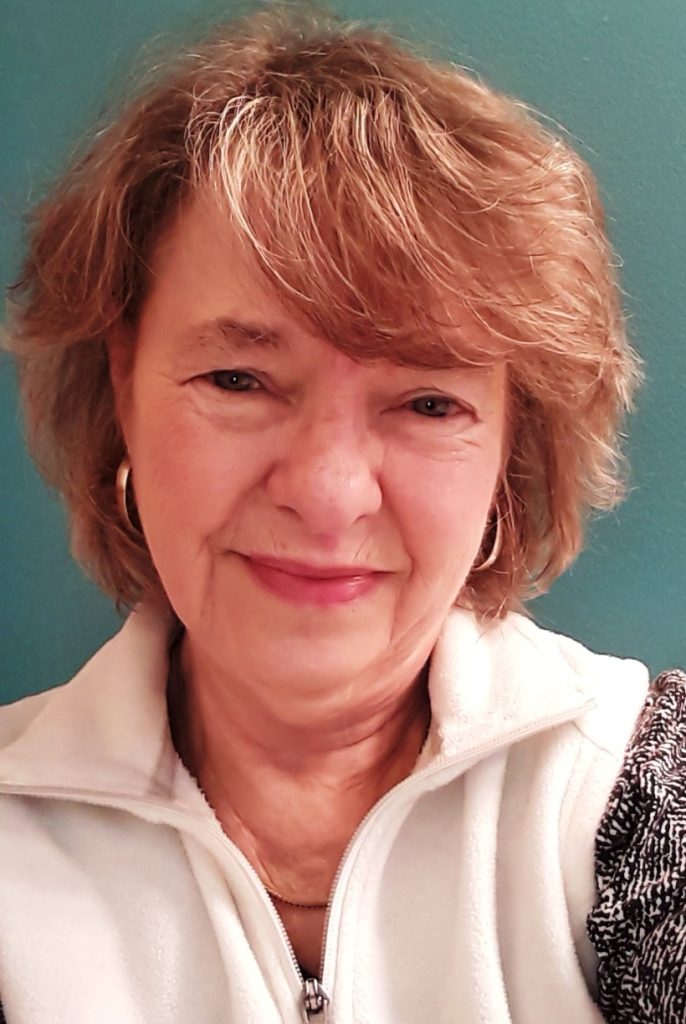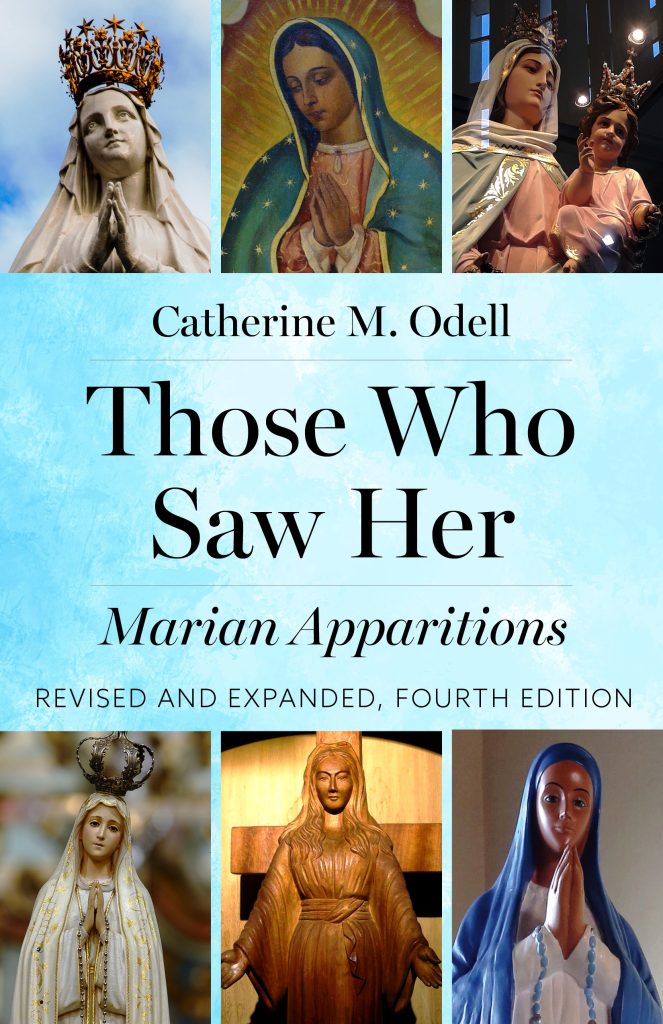March 13, 2024 // National
Local Author Shares Wisdom into Marian Apparitions
Recently, Our Sunday Visitor released a revised and expanded fourth edition of “Those Who Saw Her: Apparitions of Mary” by local author Catherine M. Odell. Catherine and her husband, Bill, are active members of St. Therese, Little Flower Parish in South Bend.
Odell spoke to Today’s Catholic about how she came to write about Marian apparitions, her latest version of the book, and how she views the messages of Mary as they relate to the world today.
Today’s Catholic: The first edition of “Those Who Saw Her” was published in 1986. Why did you write the book in the first place?
Catherine Odell: OSV asked if I would be interested in writing such a book. Interest in Marian topics was growing at that time, in part because of worldwide
interest in the alleged apparitions of Our Lady at Medjugorje in Bosnia-Herzegovina. In fact, huge annual Medjugorje conferences were being held at the University of Notre Dame. In addition, all the popes in our lifetime have also had a strong devotion to the Blessed Mother and have visited several of the apparition sites mentioned in the book.
Today’s Catholic: How about this fourth edition?
Odell: Again, it came about because the publisher felt there was ongoing interest. The whole Church seems to have a growing appreciation for Marian devotions that so many Catholics find helpful. Also, since the last edition of the book, the Church has declared several apparitions “worthy of belief,” including the only one in the United States, at present-day Champion, Wisconsin, in the Green Bay diocese. Although it was in 1859 that Mary appeared as Our Lady of Good Help to a Belgian immigrant, Adele Brise, those beautiful apparitions weren’t approved by the Church until 2010. At Champion, Mary asked 28-year-old Adele to teach children to pray and practice their faith. Other recent developments include the canonization of Guadalupe’s Juan Diego and Fatima’s Jacinta and Francisco Marto, the Church’s youngest saints.
Today’s Catholic: What other changes or improvements are found in the fourth edition?
Odell: I love the cover, which has images of Our Lady from all across the world, demonstrating that Mary’s visits are global. There are also new photographs of the seers and apparition shrines, statues and other artwork in the appropriate chapters rather than a few in one central section. Apart from Our Lady of Guadalupe, all the apparitions in the first edition occurred in Europe. Besides the one in North America, the fourth edition includes one from Japan (Akita), one from Rwanda (Kibeho), and two from South America (San Nicolas, Argentina, and Betania, Venezuela). There is also a chapter on recently approved apparitions at Laus, France, from 1664 to 1718.
Today’s Catholic: Is there anything striking for you about all these apparitions when considered together?
Odell: They are all so different! In some, a single person saw Our Lady, in others, a whole village. Some, like Knock, were visual but no words were spoken. Some lasted a day, others through a period of many years. In some cases, you could say that the apparition continues – through the Miraculous Medal whose design Our Lady revealed to St. Catherine Laboure at Rue deBac, and the image she left behind on Juan Diego’s tilma.
Today’s Catholic: How would you summarize Our Lady’s messages?
Odell: In the midst of war at Portmain in France, and in the midst of famine in Ireland, consolation seems to have been her primary purpose. But in other apparitions, she often urges us to repent, to return to the sacraments, to intercede for others, and to pray the Rosary. Frequently, she also desires that a church or shrine be built in her honor. These places of worship are another way that the benefits of apparitions can be ongoing.
Today’s Catholic: What would you like to say about the introductory chapters?
Odell: When I first wrote the book, I had a lot to learn about how the Church sees and studies apparitions. So, I felt it was important to share this research at the beginning of the book. These introductory chapters lay important groundwork for the accounts of the actual apparitions. “Who Is Mary?” summarizes the major Church teachings about the Blessed Virgin Mary. In “Why Does Mary Come?” I explore what some prominent Mariologists have suggested. One memorable explanation is that Mary’s appearances are like billboards that remind us of essential truths to which we’ve become inattentive. “The Church and Apparitions” explains how the Church goes about investigating purported apparition claims, beginning with the local bishop, who can most readily interview the seers and see the fruits of their vision. I also explain how the Church evaluates the validity of apparitions. Some it declares “not worthy of belief.” They don’t seem supernatural in origin and may even convey messages contrary to Church teaching. Others contain “nothing contrary to the faith” but haven’t been officially authenticated. Pilgrims aren’t forbidden to visit such sites. The final category is those “worthy of belief.” But even then, no apparition is an article of faith. No Catholic is obligated to believe Mary has appeared in any of these places.
Today’s Catholic: Have you yourself visited any of the Marian apparition sites?
Odell: I actually went to Lourdes before I even wrote this book. I still don’t know why, but Doubleday asked me to accompany Father Ralph DiOrio, a priest with a healing ministry, on a pilgrimage to the Holy Land, Rome, and Lourdes. I wrote about that pilgrimage in a 1984 book, “On Pilgrimage” with Father Ralph DiOrio. Despite his popularity, the book sold very poorly. We pilgrims didn’t spend much time in Lourdes, but it is a lovely, holy spot. I remember feeling a bit shocked by the commercialization there – so many shops selling religious souvenirs! I also hope to visit Champion, perhaps this summer.
Today’s Catholic: Why do you think there’s been so little interest in our own American apparition site in nearby Wisconsin?
Odell: That mystifies me. Perhaps it’s not exotic or distant enough? And many, many decades elapsed before it was again studied by the Church and then declared “worthy of belief.” Perhaps there will be a growing and gradual awareness of it, first of all, and then a devotion to what Mary had to say there.
Today’s Catholic: The first apparition in this book occurred in 1531. What was Mary doing the first 1,500 years of the Church?
Odell: Mary has visited her people throughout Church history, but many of her earlier appearances were private revelations to individual saints rather than messages directed to the entire Church. And later in the history of the Church, the Church itself developed specific guidelines for the study and assessment of reported apparitions. Today, the Vatican’s Dicastery for the Doctrine of the Faith provides those guidelines that dioceses can use to assess apparition reports.
Today’s Catholic: Why do you think Mary so often chooses children and the uneducated to receive and share her messages rather than “influencers”?
Odell: I’m guessing it’s because it’s harder to accuse children of trying to gain power by fooling people. However, most of these seers suffered a great deal. Either people didn’t believe them and went to great lengths to suppress the messages, or they attracted so much attention that they had to recount their stories again and again. At least with the seers of LaSalette, what people expected of them – entering religious life
The best news. Delivered to your inbox.
Subscribe to our mailing list today.








